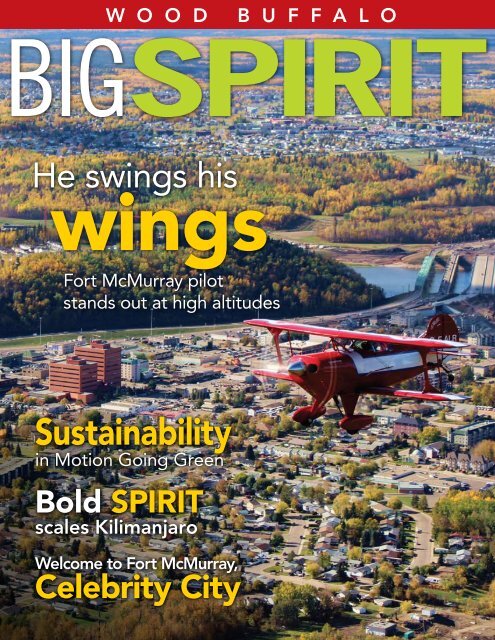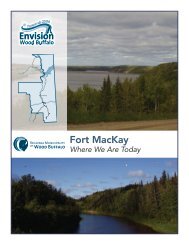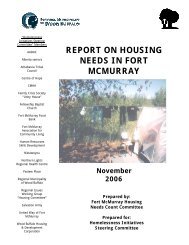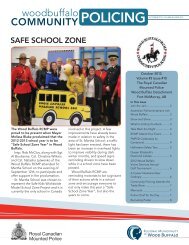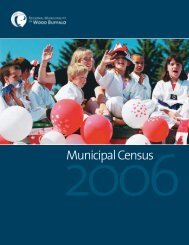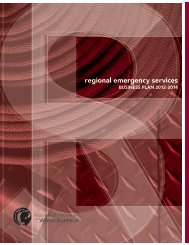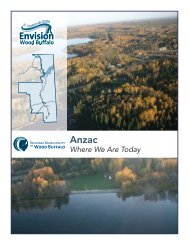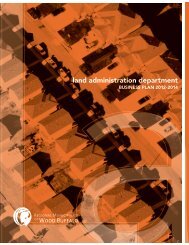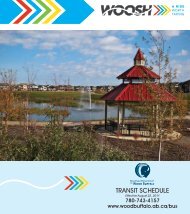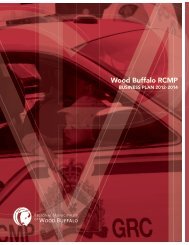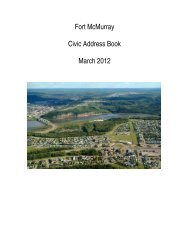Sustainability - Regional Municipality of Wood Buffalo
Sustainability - Regional Municipality of Wood Buffalo
Sustainability - Regional Municipality of Wood Buffalo
You also want an ePaper? Increase the reach of your titles
YUMPU automatically turns print PDFs into web optimized ePapers that Google loves.
W o o d b u f f a l oBigSpiritHe swings hiswingsFort McMurray pilotstands out at high altitudes<strong>Sustainability</strong>in Motion Going GreenBold spiritscales KilimanjaroWelcome to Fort McMurray,Celebrity City
contentsCoverStory Issue 5Contents Photos: Clockwise, Curtis Comeau,Curtis Comeau, Paul Jen, Curtis Comeau, Curtis ComeauCover32 He Swing His WingsFort McMurray pilot stands out at high altitudesby Myra RossFeatures8 <strong>Sustainability</strong> in motionThe Greening <strong>of</strong> <strong>Wood</strong> <strong>Buffalo</strong>, One Bus at a Timeby Myra Ross14 The city that inspires successby Kyla Getty15 Adventurous Spirit Attains the Summit13-year-old Maria Fustic sees the world from anexclusive vantage pointby Nolan Haukeness19 Sport: Building a Lasting Legacy<strong>Wood</strong> <strong>Buffalo</strong>’s 2015 Games Committeeby Kiran Malik-Khan21 Fort McMurray: The Growing Celebrity CityBig-time celebrities and superstars light up Fort McMurrayby Monica Leslie25 Teaching Life’s Lesson Through ArtArtist uses a vibrant palette for the ABCsby Myra Ross28 The Diverse, Vibrant Voices <strong>of</strong> Fort McMurrayNewcomers find abundant resources to help themcommunicate and connectby Monica LeslieColumns4 Message from the MayorMoving Forward!by Melissa Blake5 IN THE COMMUNITY<strong>Wood</strong> <strong>Buffalo</strong> skates away with prestigious award;Connecting with Culture; Future Forward Place;TED-inspired video explains The Municipal DevelopmentPlan; Municipal Watch Program launched;MACOY barbecue7 True or FalseBig Spirit: <strong>Sustainability</strong>34 Back Page SpecialBig Spirit <strong>of</strong> the Past: William McMurrayEditor's NoteThe <strong>Wood</strong> <strong>Buffalo</strong> Environmental Association would like to pointout that the article entitled ‘The science behind studying air quality’that appeared in the spring edition <strong>of</strong> Big Spirit was changedfrom the submitted version. The original article may be found onthe WBEA website at www.wbea.orgOn the Cover: Michael Plouffe flies above downtown Fort McMurray in his Pitts Special biplane. Photo by Kelly GerkeIssue 5 | www.bigspirit.ca | Bigspirit 3
FROM THE MayorMoving forward!Most appropriately, the Western Cities Conference hosted by the <strong>Regional</strong> <strong>Municipality</strong> <strong>of</strong> <strong>Wood</strong> <strong>Buffalo</strong> inSeptember was named ‘The Amazing Pace: Building an Organization, Building a Community!’Almost everything in our great region, from roads to school facilities to community programming, is in theprocess <strong>of</strong> either being built from the ground up or revitalized. This pace and progress are in alignment withthe implementation <strong>of</strong> our new Municipal Development Plan, our roadmap for the next 20 years. And whilegrowth and progress are the benchmarks <strong>of</strong> our future, they cannot surpass or match the significance <strong>of</strong> ourcommitment to sustainability.The thing that stood out most about this publication’s articles and themes was their demonstrations <strong>of</strong> BigSpirit and innovation and our aspirations for a healthy and balanced economic, environmental and collaborativefuture, not only for our region, but for the world beyond.The unprecedented collaboration between local government and industry with respect to eliminatinggridlock and enhancing our transportation efficiencies is one <strong>of</strong> the most refreshing developments we arewitnessing. This initiative is a striking counterbalance to concerns about our carbon footprint and how we cando together what we cannot do separately. It is Big Spirit in motion.Undoubtedly, the <strong>Regional</strong> <strong>Municipality</strong> <strong>of</strong> <strong>Wood</strong> <strong>Buffalo</strong> seems to attract and nurture the adventurousamong us and that is certainly evidenced by the amazing achievement <strong>of</strong> 13-year-old Maria Fustic. In climbingKilimanjaro, while fundraising for children in Africa, she demonstrates the type <strong>of</strong> character and vision that wevalue as Canadians – and the initiative and spirit <strong>of</strong> giving that sets <strong>Wood</strong> <strong>Buffalo</strong> apart.And, looking ahead, there will be a very long list <strong>of</strong> tasks as we proudly prepare to host the 2015 SummerGames, a recreational event that will draw more than 2,500 youth, their coaches, family members and friends toour region. Our region’s reputation as a community <strong>of</strong> volunteers will be put to the test. This undertaking cannotpossibly be a success without the support <strong>of</strong> our residents. As the first northern community to be privileged tohost the Games, we are looking forward to providing participants with experiences to last a lifetime.These stories tell us more about who we are, what we value and what we are doing to sustain our natural andhuman resources.Sincerely,Melissa Blake, Mayorbig SpiritIssue 5e d i t o r Myra RossMyra.Ross@woodbuffalo.ab.caa r t d i r e c t o r Kathleen Regan-Vandermoerkregan-vandermoer@rogers.comc o p y e d i t o r Bert Vandermoerbert.vandermoer@rogers.comBigspirit is published by the <strong>Regional</strong> <strong>Municipality</strong> <strong>of</strong> <strong>Wood</strong> <strong>Buffalo</strong>, www.woodbuffalo.ab.ca.We acknowledge the financial support <strong>of</strong> the <strong>Regional</strong> <strong>Municipality</strong> <strong>of</strong> <strong>Wood</strong> <strong>Buffalo</strong>, toward ourmailing and editorial costs. Our environmental policy is available at www.woodbuffalo.ab.ca.Bigspirit is printed in Canada. © 2011 by <strong>Regional</strong> <strong>Municipality</strong> <strong>of</strong> <strong>Wood</strong> <strong>Buffalo</strong>.Bigspirit receives unsolicited materials (including letters to the editor, press releases,promotional items and images) from time to time. Bigspirit, its affiliates and assignees mayuse, reproduce, publish, republish, distribute, store and archive such submissions in whole or inpart in any form or medium whatsoever, without compensation <strong>of</strong> any sort. This statement doesnot apply to materials/pitches submitted by freelance writers, photographers or illustrators inaccordance with known industry practices. PHOTOCOPYING: No part <strong>of</strong> this publication may bereproduced, stored in a retrieval system or transmitted, in any form or by any means, without theprior written consent <strong>of</strong> the publisher or, in case <strong>of</strong> photocopying or other reprographic copying, alicence from Access Copyright.4 Bigspirit | www.bigspirit.ca | Issue 5
in the community> <strong>Wood</strong> <strong>Buffalo</strong>skates away withprestigious awardMayor Melissa Blake proudly accepted theOutstanding Achievement Award for the FortChipewyan ice initiative at the 2011 Minister <strong>of</strong> MunicipalAffairs’ Awards <strong>of</strong> Excellence at the Alberta UrbanMunicipalities Association (AUMA) convention held inCalgary Sept. 28-30.Fort Chipewyan’s Archie Simpson Arena’s syntheticice was cited as a leading practice by the AUMA. Apractical, economical and environmentally friendly alternative,synthetic ice was installed at the Archie SimpsonArena to provide increased, year-round recreationalopportunities for the residents.“Our <strong>Municipality</strong> prides itself on innovation and tobe recognized by the Province… is an honour,” MayorBlake said on accepting the award. “I am especiallyproud <strong>of</strong> our Municipal employees who thought outsidethe box to respond to the needs <strong>of</strong> our residents.”When the NHL-sized rink opened in 2010, it attractedconsiderable media attention and the <strong>Municipality</strong> hasbeen approached by other Canadian communities to <strong>of</strong>ferinsight into its experience with synthetic ice.Four <strong>of</strong> approximately 40 participants at the Cultural Crossroads workshop collaborated to define ‘CulturalCompetency’. From left to right are: Linda Ryan, <strong>Wood</strong> <strong>Buffalo</strong> Police Services, Mary Thomas, KeyanoCollege Corporate Training, Marguerite Bloem, <strong>Wood</strong> <strong>Buffalo</strong> Planning and Carole Bouchard, <strong>Wood</strong> <strong>Buffalo</strong>Community Services.> Connecting with Culture<strong>Wood</strong> <strong>Buffalo</strong> is noted for its cultural diversity,which was the focus <strong>of</strong> a Cultural CrossroadsWorkshop at the Merit Hotel on Oct. 6.Hosted by the <strong>Regional</strong> <strong>Municipality</strong> <strong>of</strong> <strong>Wood</strong><strong>Buffalo</strong> and facilitated by the Centre <strong>of</strong> Race andCulture (CRC) the workshop explored culturalcompetency, diversity and inclusion practices inAlberta today.Ricardo Carlos and Ian Mathieson, CRCassociate directors, engaged with the audience <strong>of</strong>42 participants on how to maximize the advantagesand minimize the challenges <strong>of</strong> working with a diverseworkforce.Canada is <strong>of</strong>ten viewed internationally as abenchmark <strong>of</strong> cultural diversity.“The world is looking at Canada as the experimenton multiculturalism,” Ricardo Carlos said. “It hasn’tworked well in other countries because it hasn’t reallybeen thought about and talked about.”Carlos, a light-skinned man, said that when heopens his mouth and others hear his accent, peopleare taken aback. And then, when he says he’s fromMexico, people are even more perplexed. “They say Idon’t look like a Mexican,” says Carlos, “but what doesa Mexican look like?”Touchy topics such as racism were also discussed.Racism was defined as any action or practice consciousor subconscious, backed by a systematic or institutionalpower that subordinates people predominantly based ontheir colour or other physical attributes.Photo by Myra Ross> Future Forward PlaceThe newly renovated Municipal storefront at 9717 FranklinAve., with its open space design as the new work centre forComprehensive Planning (long-term planning), <strong>of</strong>ficially openedits doors to the public in September with a traditional ribboncuttingceremony. Shown left to right are: Rick Stuckenberg,Acting Manager <strong>of</strong> Community Development, Planning andDevelopment; Glen Laubenstein, Chief Administrative Officer;Mayor Melissa Blake; Dr. Samuel Alatorre, Director, Planningand Development; and Francisco Bermejo, Acting Manager <strong>of</strong>Comprehensive Planning, Planning and Development.Issue 5 | www.bigspirit.ca | Bigspirit 5
in the community> TED-inspiredvideo explainsThe MunicipalDevelopment PlanOn Oct. 25, the <strong>Regional</strong> <strong>Municipality</strong> <strong>of</strong> <strong>Wood</strong><strong>Buffalo</strong> adopted The Municipal DevelopmentPlan (MDP), its vision for the future and theguidelines necessary for sustainability, buildingeconomic resilience and managing the region’sprojected tremendous growth over the next twodecades.To keep residents and stakeholders informedabout the MDP, the region created a TED-inspiredvideo that explains the MDP in a matter <strong>of</strong> minutes.To view the video, go to http://www.youtube.com/rmwbwebmaster#p/a/u/0/jAJxoRCsKfcMunicipal employees will be on the lookout for suspicious behaviour.> Municipal Watch Program launched<strong>Wood</strong> <strong>Buffalo</strong> employees are adding a newchapter to a proven success story.It’s called the Municipal Watch Program(an adaptation <strong>of</strong> City Watch), which is alreadyhelping to clean up neighbourhoods in more than27 municipalities in B.C.The premise is that Municipal employees<strong>of</strong>ten observe suspicious activities throughoutthe community during their daily routines andthat it is in the interests <strong>of</strong> public safety forthose observations to be directed to the properauthorities.And, following launch speeches at the JubileeCentre on Sept. 21 by Mayor Melissa Blake, RCMPSgt. Scott Bell and Della Kerfont, vice-president, CupeLocal 1505, staff and passersby enjoyed a BBQ <strong>of</strong>hamburgers and hot dogs hosted by Local 1505.“We as CUPE members are proud to give backto the community where we work and live,” saidDella Kerfont, the Full-Time Officer <strong>of</strong> Cupe Local1505. “The idea is to help the RCMP in reducingcrime and making our community a safer place forour families.”Through the program, employees will begiven special training (that takes approximately15 minutes) on how to watch and report suspiciousor criminal activities.All Municipal vehicles will have the programinstructions and report forms that enableemployees to describe the ‘Who, What, When,Where, Why and How’ <strong>of</strong> any incidents thatcause concern, as well as other details, such asvehicle licence plate numbers and descriptions <strong>of</strong>individuals <strong>of</strong> interest.> MACOY barbecue Members <strong>of</strong> the 2011 Mayor’s Advisory Committee On Youth gathered with Mayor Melissa Blake to enjoy a barbecue at theend <strong>of</strong> their very active year. Two among the group received awards from the Fort McMurray Chamber <strong>of</strong> Commerce in October. Brooke McMillan received the Leaders<strong>of</strong> Tomorrow Award and Max Weinberger received the Xceptional Kidz Award. The purpose <strong>of</strong> MACOY is to empower youth to become actively engaged citizenswho have a voice in decisions that affect them. MACOY members are champions <strong>of</strong> the community who work to improve the quality <strong>of</strong> life <strong>of</strong> all citizens.Shown in the photo are: Back Row (L-R): Lase Baiyewun, Julie Dolmont (Advisor), Michée-Ana Hamilton, Fareeha Salahuddin, Fardosa Hersi, Sara Naser, Abhi Shah, DillonHargreaves, Elias Leon, Lei Sheng, Brooke McMillan (Alumni), Mayor Melissa Blake. Front Row: Norma Shaw (Advisor), Saharsh Shah, Akash Gupta, Max Weinberger.6 Bigspirit | www.bigspirit.ca | Issue 5
True or FalseBig Spirit: <strong>Sustainability</strong>Take the quiz and find out what is being done to support sustainability.1<strong>Sustainability</strong>: Local government hasno power when it comes to supportingsustainability within the region.FALSE: In 2010, Council adopted Envision <strong>Wood</strong> <strong>Buffalo</strong>,a development plan that highlights, promotes and ensuressustainability in Municipal governance and operations. Italso adopted a bylaw that required the elimination <strong>of</strong> ‘oneshop’plastic bags being used at most retail outlets. Other‘sustainability’ measures include the approval <strong>of</strong> bus lanes,bike paths and Leeds-level (green) standard for Municipalfacilities.2Water: The Oil & Gas Industry uses toomuch water, a diminishing, finite resource.FALSE: For example, in 2009, irrigation and agriculturerepresented 44 per cent <strong>of</strong> the total provincial allocations,while the oil sands industry made up seven per cent. Andnot all <strong>of</strong> that water was used; it uses less than one-third<strong>of</strong> its total water allocation per year.3Economy: Only Alberta benefits from OilSands development.FALSE: Although Alberta receives about 94 per cent<strong>of</strong> the economic benefits from oil sands, the economicimpact across Canada is significant.4Shelter Affordability: Families cannotconsider settling in <strong>Wood</strong> <strong>Buffalo</strong> because<strong>of</strong> the high cost <strong>of</strong> real estate.FALSE: <strong>Wood</strong> <strong>Buffalo</strong> residents enjoy incomes 95 per cent higher thanthe national average and the estimated 2011 household expenditure onshelter is $27,884. Sixty-four per cent <strong>of</strong> households in <strong>Wood</strong> <strong>Buffalo</strong>have an income over $100,000; the average household projected incomefor 2011 is $177,634.5Inclusive: The oil sands respects the cultural diversity<strong>of</strong> the <strong>Regional</strong> <strong>Municipality</strong> <strong>of</strong> <strong>Wood</strong> <strong>Buffalo</strong>.TRUE: In 2010, oil sands companies contracted more than $1.3 billionfor goods and services from Aboriginal-owned businesses.6Rich Culture: <strong>Wood</strong> <strong>Buffalo</strong> is a place wherediversity flourishes.TRUE: <strong>Wood</strong> <strong>Buffalo</strong> has six First Nations peoples (Smith’s LandingFirst Nation was created recently) residing within its politicalboundaries as well as seven Métis groups. Aboriginal awarenessorientations are <strong>of</strong>fered to municipal employees within the first year <strong>of</strong>their hire; the municipality also frequently hosts workshops on diversitywithin the community since diversity <strong>of</strong> population is no longer a goal,it is the reality. Numerous local service agencies provide support tonewcomers from around the globe in order to improve interculturalcommunication and experiences.Issue 5 | www.bigspirit.ca | Bigspirit 7
sustainabilityStoryMoving <strong>Wood</strong> <strong>Buffalo</strong> transit forward to greater efficiencies are, left to right, Samuel Alatorre, Director, <strong>Wood</strong> <strong>Buffalo</strong>Planning and Development; Carolyn Wozniak, <strong>Wood</strong> <strong>Buffalo</strong> Transit and Kevin Stinson, VP <strong>of</strong> Pacific Western Transit.And if you have creature comforts likea Y5 connection so that the bus equateswith productivity, it becomes a ride <strong>of</strong>choice from an industry standpoint.”Transit must and shall becomeconvenient, reliable and predictable –and that will only be the beginning,according to Sam Alatorre, <strong>Wood</strong><strong>Buffalo</strong>’s Director <strong>of</strong> Planning andDevelopment.“This is only the first stepping stone togetting us to an integrated transit networkand system,” explains Alatorre. “We hadtransportation expert Sam Zimmermanhere during the MDP process to talk aboutan integrated corridor system and it’sevident that whether it’s a municipal or anindustry bus, it should be seamless to meas a rider.”Clearly, when the municipality andindustry stakeholders are operatingbus systems to convey residents andworkers from the same boarding areasto the same destinations, there areopportunities for enhanced efficiencies.“The biggest step forward is thatwe’re all at the same table and we’reall speaking the same language: Thegoal <strong>of</strong> sustainability is the same foreverybody.“The conversations betweenthe municipality and industry areprogressing very rapidly.”CAO Glen Laubenstein:Focused on the FutureMunicipal CAO Glen Laubensteinclearly remembers the day that trafficnorthward to Suncor and Syncrude wasbacked up southward to the SawridgeHotel. “It was brutal,” he recalls.He definitely plans to change thatscenario.As the former CAO <strong>of</strong> Winnipeg,Manitoba, the home <strong>of</strong> New Flyer, theinternational manufacturer <strong>of</strong> low, highand alternate fuel transit buses, and theformer CAO <strong>of</strong> Kingston, Ontario, thehome <strong>of</strong> Bombardier, the largest supplier<strong>of</strong> light rail in the world, Laubensteinhas limited tolerance for gridlock andan astute, enthusiastic appreciation <strong>of</strong>innovation.“The municipality is collaboratingwith industry, school boards andKeyano College, and with itself, becausetoo <strong>of</strong>ten when we think <strong>of</strong> greeningtransportation we jump to buses andtrains and then come to a full stop,” saysLaubenstein.“But the one we haven’t had any realtraction on yet and one that I think is abig plus, is Car Pool dot com, a s<strong>of</strong>twareprogram available in a lot <strong>of</strong> cities.“With it, you can find out if there’sanybody going by with an empty seat,Photo by Curtis Comeau12 Bigspirit | www.bigspirit.ca | Issue 5
sustainabilityStoryand if we can get four people in amunicipal vehicle to get people to andfrom work, they won’t need second carsin their garages.“There will be fewer and fewersingle-occupant vehicles. We may lookat carpooling our municipal car fleetwith other government agencies sowe get greater value from them. Wehave opportunities to do all kinds <strong>of</strong>things that are all a part <strong>of</strong> greeningtransportation initiatives.”<strong>Wood</strong> <strong>Buffalo</strong>, theGeneration Y meccaGreening <strong>Wood</strong> <strong>Buffalo</strong>’s transportationsystem is likely to be embraced morecomprehensively by resident ridersthan in other urban areas in Canadaand North America because <strong>of</strong>demographics.The mean age <strong>of</strong> <strong>Wood</strong> <strong>Buffalo</strong>residents is 31 and one <strong>of</strong> the largestgenerational groups ranges in age from20 to 29.While social and economic status for40 to 60-year-old adults may be a sleekMercedes or a fully outfitted Hummer orDodge Ram, Gen Ys aren’t as groundedin dinosauric, four-wheeled symbols <strong>of</strong>success.“It’s the young people who will changethings,” Smith continues. “They’ll get onboard with convenient, predictable, fasttransit and they’ll drive it.“We’re trying to serve thatgeneration. That’s who will consolidatethis city for the future.“The new status has to do with theenvironment and our quality <strong>of</strong> life andnot the type <strong>of</strong> vehicle you’re drivingtoday.“The Gen Ys are the people who willmake the difference.”The Province <strong>of</strong> Alberta recently enacted its ‘Distracted Driving’ legislation, which makes itillegal to text or talk on cellphones while driving a vehicle. Meanwhile, <strong>Wood</strong> <strong>Buffalo</strong>’s newbuses can be used as mobile <strong>of</strong>fices and ‘connectivity’ coaches, features that should lure Gen Ycommuters and others to public transit.Photo by Curtis ComeauIssue 5 | www.bigspirit.ca | Bigspirit 13
AdventurousSpiritAdventurousspiritattains the summit13-year-old Maria Fusticsees the world from anexclusive vantage pointby Nolan HaukenessNot many people have seen the view from the top <strong>of</strong> theworld, let alone at the age <strong>of</strong> 13.Maria Fustic, though, is not your average, everydayteenager.When speaking with her, it’s easily forgotten that she becamea teenager not so long ago. Most girls her age are either obsessingover the latest boy band or busy hanging out at the mall. She is wisebeyond her years and her ability to channel a ‘can-do’ attitude intoawe-inspiring accomplishment is growing as fast as she is.Perhaps that can be attributed to the fact that she has travelledIssue 5 | www.bigspirit.ca | Bigspirit 15
GamesStorySport:Building a lasting legacy<strong>Wood</strong> <strong>Buffalo</strong>’s 2015 Games Committee mustmeet competition requirements by Kiran Malik-Khan“Ifyou build it, they will come,” says a voice that novice farmer Ray Kinsellahears in the blockbuster movie ‘Field <strong>of</strong> Dreams.’And never have those words been truer than in the case <strong>of</strong> the <strong>Wood</strong><strong>Buffalo</strong> Summer Games 2015. From Jersey Day to the massive peprally, <strong>Wood</strong> <strong>Buffalo</strong> showed its Big Spirit and impressed all the members <strong>of</strong> the ProvincialSelection Committee with the result that Cindy Ady, Alberta Minister <strong>of</strong> Tourism, Parks andRecreation, granted the games to the <strong>Regional</strong> <strong>Municipality</strong> <strong>of</strong> <strong>Wood</strong> <strong>Buffalo</strong>.Held every four years, this will be the first time the Western Canada Summer Games arehosted in a northern community. Slated for August 2015, the 10-day event will see more than2,500 participants in 18 different sports. Targeting athletes ranging in ages from 11 to 17,the region will host guests from all over Canada including British Columbia, Saskatchewan,Manitoba, Yukon, Northwest Territories, Nunavut and Alberta, so the <strong>Wood</strong> <strong>Buffalo</strong> 2015Games Committee is now working hard to secure facilities, which will benefit the region onmultiple levels.Two major sports requiring buildings are rowing and beach volleyball. With specificrequirements for both, the Games Committee is still deliberating whether permanent ortemporary facilities need to be built.“Rowing, canoeing, and kayaking are a significant part <strong>of</strong> the games, and we don’t have18 Bigspirit | www.bigspirit.ca | Issue 5
GamesStorycommittee could undertake it as a capitalproject. It’s not an overwhelming project,”continues Fitzner.He adds beach volleyball is rapidlygaining popularity due to its lowmaintenance nature.“It takes only four people. We havefour high schools, Keyano College andlong summer nights in <strong>Wood</strong> <strong>Buffalo</strong>.There is a lot <strong>of</strong> potential.”Additionally, he briefly touched onrunning and the possibility <strong>of</strong> creating a100- or 220-metre indoor track and field. Thesubstantial benefit for the community wouldbe allowing athletes to train year-round.“We have so many accomplishedrunners and eight months <strong>of</strong> winter.This will level the playing field. We cancultivate their talents.“This is about creating a sustainablesport environment for our youth. Thepriority is to leave a lasting legacy. Ifwe can give them these facilities totrain in, maybe we can send them tothe next Games” notes Fitzner, who isthe President <strong>of</strong> the Casman Group <strong>of</strong>Companies.Both Fitzner and Lockhart visitedKamloops this summer to shadow the2011 Summer Games hosted there. Theysay while Kamloops was impressive, theyare confident <strong>Wood</strong> <strong>Buffalo</strong> can also do agreat job.At the end <strong>of</strong> the day, Lockhartsays, the Games are not about buildingfacilities, but building a sports structurein the region from the grassroots up toan elite level. The goal, she emphasizes, isto mentor and build capacity within thecommunity for the next games.“We want to be able to leave a legacyto pursue national and internationalsports events. This is not only great for thecommunity, but also for tourism. With2,300 athletes come 2,300 sets <strong>of</strong> parents.Everyone will hear about our regionand see how diverse, vibrant, young andgiving our community is. The facilitiesare a bonus,” said Lockhart.Previous multi-sport events hosted in<strong>Wood</strong> <strong>Buffalo</strong> include the 1992 AlbertaWinter Games, the 2003 Alberta SeniorGames and the 2004 Arctic WinterGames.Kiran Malik-Khan is a freelance writerbased in Fort McMurray.Photo by Chris SalvoMacDonald Island Park is hosting many <strong>of</strong> the sports events for the games.20 Bigspirit | www.bigspirit.ca | Issue 5
citylightsCanada’s ‘Do it Right’man Mike HolmesFort McMurray:The Growing Celebrity CityBig-time celebrities andsuperstars light up Fort McMurrayby Monica LeslieThere’s something happening in <strong>Wood</strong> <strong>Buffalo</strong>. Once described as anisolated northern municipality that encompasses Canada’s oil sands, the<strong>Municipality</strong> is seeing a shift in perception. The shift has come from within,spurred on by the needs <strong>of</strong> the people who live here, who want more than abusy life <strong>of</strong> work.Anywhere you go, culture and recreation are being delivered as an escape from thelong hours <strong>of</strong> work that normally define life in Fort McMurray. With the emergence<strong>of</strong> high-quality concert venues, community events and recreation facilities, as well asdedicated event planners, <strong>Wood</strong> <strong>Buffalo</strong> is bringing in the top entertainment acts thatyou expect to find in any metropolitan city. This development has served to show thatPhoto by Paul JenIssue 5 | www.bigspirit.ca | Bigspirit 21
citylightsKISS member Gene Simmons strikes his famous pose on stage at MacDonald Island Park.22 Bigspirit | www.bigspirit.ca | Issue 5<strong>Wood</strong> <strong>Buffalo</strong> is not merely a place tomake money, but also an excellent placeto call home and to enjoy all that it has to<strong>of</strong>fer.And it <strong>of</strong>fers a lot more than you’dthink.If you are a Canadian and you watchHGTV, you know the ‘do it right’ man.Mike Holmes, the keynote speakerat the September Western CitiesConference, ‘The Amazing Pace:Building an Organization, Buildinga Community!’, elaborated on what itmeans to ‘do it right’ when it comesto a high-growth powerhouse like the<strong>Regional</strong> <strong>Municipality</strong> <strong>of</strong> <strong>Wood</strong> <strong>Buffalo</strong>,which hosted the conference.With unmatched passion, Holmesoutlined how we all need to start beinggreen and shared a personal anecdoteabout Canada’s Prime Minister StephenHarper. In conversation with the PrimeMinister, Holmes said: “Steve, we’re allthinking green, we’re all talking green,but who’s going to do it?” Not that manyCanadians call the Prime Minister ‘Steve,’but Holmes is quite down to earth andhe apparently expects others – no matterwhat their <strong>of</strong>fice – to be there as well.Holmes said he was pleasantlysurprised at the thriving community <strong>of</strong>Fort McMurray.Citing the explosive growth, thenatural beauty and the welcomingattitude <strong>of</strong> residents, he said he wasgoing to tell everyone about ‘the real FortMcMurray.’And it’s definitely growing: Just askTim Reid, Chief Operating Officer <strong>of</strong>MacDonald Island. Since joining theMacDonald Island team in 2009, Reid haswatched an unfinished recreation centregrow into a hugely popular culturaland entertainment facility, and he haswatched the community embrace andgrow with it.“We were a big community thatdidn’t have a big facility for people tocongregate and now we do,” explainsReid. “We deserve it. We’re the thirdlargestcommunity in Alberta and there’sno reason that we can’t have first-classentertainment here.”The importance <strong>of</strong> having theinfrastructure to host world-classconcerts such as July’s KISS concert aswell as successful sport events such asthe outdoor Northern Classic is huge.MacDonald Island, along with all theother cultural and recreational facilitiesin Fort McMurray, has exposed thecommunity to a vibrant, dynamic lifestylethat was not prevalent before.This feeling is shared by AndrewBoutilier, Executive Director <strong>of</strong> the FortMcMurray Oil Barons, who says, “There’scertainly an appetite and a desire to beable to do bigger-magnitude sportingevents.”The first outdoor Junior HockeyNorthern Classic was a perfect example<strong>of</strong> the community coming togetherto celebrate the tradition <strong>of</strong> Canada’snational sport. It was especiallymeaningful to <strong>Wood</strong> <strong>Buffalo</strong> for thenumber <strong>of</strong> positive news stories it created;inviting larger events has allowed theregion to create a more welcoming image.Photo by Paul Jen
citylights“It allows people in Canada to view usin a different limelight,” says Boutilier <strong>of</strong>the national attention earned by hostinglast year’s Northern Classic and the Red& White Game in August. “We directattention away from the oil sands. We’rebreathing clean air and we’re living herein the community raising our familiesand we’re raising them in the sport thatwe all grew up loving, and that’s hockey.”Many <strong>of</strong> these events depend onpassionate event planners and volunteersto make them successful. “It’s importantto provide cultural outlets – celebrationsfor people to reflect on their communityspirit,” says Misty Oakes, Event Associateat Events <strong>Wood</strong> <strong>Buffalo</strong>. “The big spiritis definitely here and it’s alive.” Hostinglarge events not only portrays <strong>Wood</strong><strong>Buffalo</strong> in a more positive light acrossCanada, but it also has a pr<strong>of</strong>ound effecton the quality <strong>of</strong> life for the peopleliving here. Cultural and entertainmentevents bring people together from allcommunities within the region, and itshows that one doesn’t have to leave FortMcMurray in order to have fun withfriends and family.With the much-anticipated WesternCanada Summer Games headed ourway in 2015, among countless otherconcerts, festivals and events to keepus entertained, the infrastructure tohost these events can only continue togrow. “We’re becoming a more activeand a more energetic community eachand every day,” says Boutilier. “As thepopulation grows, obviously you have tolook at bigger and better facilities.”Jennifer Lamontagne, LeadEvents Coordinator for Events <strong>Wood</strong><strong>Buffalo</strong>, is confident in <strong>Wood</strong> <strong>Buffalo</strong>’sentertainment and leisure prospects. “IReba McEntire was one <strong>of</strong> many first-class acts to perform at MacDonald Island Parkduring the summer <strong>of</strong> 2011.think every time we prove to everybody recreational space to a community thatwhat we can do, that we have the spirit, takes pride in showing <strong>of</strong>f what it hasthat we have the infrastructure, we have to <strong>of</strong>fer.the volunteers, we have everything that With the support <strong>of</strong> the communityneeds to come together in a package to and local organizations, the future forcreate these events and to deliver them,” world-class events and star-studdedshe says, “it allows us more opportunity celebrities in <strong>Wood</strong> <strong>Buffalo</strong> looksto go after the bidding process for future bright.events. Who knows what will come next?”<strong>Wood</strong> <strong>Buffalo</strong> has gone from a large Monica Leslie is a freelance writer basedtown without significant cultural and in Fort McMurray.Issue 5 | www.bigspirit.ca | Bigspirit 23
Sonia Burke-Smith provides ‘addedvalue’ in the classroom with art,humour and story telling.
ArtsStoryPhoto by Curtis ComeauTeaching Life’s Lessons ThroughArtby Myra RossSonia Burke-Smith is a Nor does she tell them that, in her principle <strong>of</strong> democracy, which is also thecircus carnival, a thrilling, philosophy <strong>of</strong> life, community, love and cornerstone <strong>of</strong> the Great Law <strong>of</strong> Peace inflamboyant, sense-stimulator peace, her every experience, her darkest the Native culture,” Sonia says.for young ears and eyes. Her moments, her biggest triumphs andShe explains that with the leatherrich, Phyllis-Diller-ish laughter flowsfreely and her thick cascades <strong>of</strong> long, tinyringlets move around her shoulders andback like a tango-dancing partner. Hermagnetism commands students’ silentattention as she stands at centre stagein the class, beating s<strong>of</strong>tly on the Nativedrum.“I am a visual artist,” she announcesto the 22 Grade 7 Social Studies studentsat Dr. Clark School.“I have visited many dark places onmany different roads, but the sun cameout when I found Art.”Sonia doesn’t tell them that she wasintroduced to Art in her 30s by RonHowatt, a Native artist from P.E.I., whohad a pr<strong>of</strong>ound impact on her life whenhe stopped painting canvases for her andtold her she would have to start creatingher own.She doesn’t tell them that Sid McKay,a Native elder, found her as a foster childat age 14 walking the street, cold andhungry, whereupon he brought her backto his Fort McMurray home and thenrequired her to work the trap line withhim when, somewhat rebellious, sheevery connection she has made withothers on her journey – including withthem – is for the purpose <strong>of</strong> learninglife’s lessons and sharing them withothers for their benefit.“Today our topic is the fundamentalstrapping, the wooden sticks, the feathersand the glue guns, they will each bemaking their own Talking Stick.“The principle is that when I hold theTalking Stick, I have the right to talk andwhen you hold it, you have the right to berefused to go to school.Some <strong>of</strong> Sonia’s students choosing their materials for their next piece <strong>of</strong> art.Photo by Paul JenIssue 5 | www.bigspirit.ca | Bigspirit 25
heard,” she continues.Drum set aside, shehelps students pick theirmaterials as she recallsher recent experience asan enumerator <strong>of</strong> 2,100residents in Gregoire andhow important it is as aCanadian ‘to speak andto be heard’ by castinga vote on Election Day,adding that the largestresponse she received asan enumerator was fromnew Canadians.As candid about herpassion for art as aneducational tool as sheis about her colourful,This painting by Sonia Burke-Smith illustrates the influences <strong>of</strong> Aboriginal cultureand respect for Nature in her canvases.“That’s why LearningThrough the Arts grabbedme so much, because inthe classroom, you canbe the navigator forthese kids.“That’s why providingdifferent opportunitiesto learn and differentapproaches to teaching theABCs and life’s lessons tothese kids as they go alongis so invaluable.”For example, there wasthe hot day in May whenSonia was facilitatinga Geometry throughmandala class. (Mandalas,called Sacred Circles ineventful and unconventional background,Sonia is one <strong>of</strong> approximately 25 localart educators who are sharing theircreative talents with <strong>Wood</strong> <strong>Buffalo</strong>’selementary school students in more than100 classrooms this fall and another 100classrooms next spring.In her third year as a LearningThrough the Arts educator, Soniais noted for her gift <strong>of</strong> being able toconnect with all <strong>of</strong> her students but, inparticular, with those who have mindslike Albert Einstein, Isaac Newton andthe lesser known but no less brilliantinventor Nikola Tesla, each <strong>of</strong> whom fitssomewhere on the spectrum <strong>of</strong> ‘differentminds’ <strong>of</strong>ten described by the termsAsperger syndrome, Attention DeficitHyperactivity Disorder (ADHD) andAutism.Sonia’s eyes light up at the mention<strong>of</strong> Temple Grandin, a successful femalescientist who describes how autisticpeople think in the YouTube TED videolearning series on different minds anddifferent ways <strong>of</strong> thinking.Sonia describes these ‘special’students as creative learners.“They think in pictures – theydon’t think in language, so they learndifferently,” she says.And Sonia certainly understandswhat’s involved when one is different,distinctive and not your ‘average’ student.“I was around 10, the age when manykids know that something is wrong butthey have no idea what it is.“For me, I went into foster care at age12 and when much later in life I found outI had ADHD and other great stuff, I went‘Oh, I’m just different’ and then you figureout that’s okay and new worlds open up.“If that realization can happen foryou as a youngster and you know youare different in your thinking and thatit’s all right, you can just move on.There’s no mystery to be solved. Youbecome you.Aboriginal belief systems and someworld religions, translate complexmathematical expressions into simpleshapes and forms.)“It was so hot that day it was like theyall had ants in their pants,” she says.“I felt it too.“I was losing them.“We always have a hands-on activityso I set the task to each student <strong>of</strong>creating a mandala as a message <strong>of</strong> hopefor the students in Slave Lake who hadlost everything in the fire.“One <strong>of</strong> the lessons we, they, mustlearn is that you need to be regulatingyour emotions but also be giving as well.“No one complained again that dayabout the heat.“They were too busy creatingmandalas as messages <strong>of</strong> hope.”Editor’s note: At press time SoniaBurke-Smith’s canvases were on display atMacDonald Island Community Art Gallery.26 Bigspirit | www.bigspirit.ca | Issue 5
ArtsStoryLearning Through the Arts Program<strong>of</strong> Fort McMurrayThe Learning Through the Arts (LTTA)program brings specially certified artistsinto hundreds <strong>of</strong> schools across Canada andinternationally.In partnership with great teachers, the arteducators create lessons using the arts toenliven core curriculum.LTTA has also developed a customizedprogram designed for Aboriginal schools andcommunities, integrating Aboriginal language,artists and art forms.In 2010, the Alberta government provided$1.3 million in funding for the implementation<strong>of</strong> LTTA in Fort McMurray with the main focusto be on Aboriginal youth in the classroom forthe specific purpose <strong>of</strong> keeping them engaged inlearning through to graduation.Art educators include writers, visual artists,photographers, musicians, poets, sculptors – allartists.Those who undertake the LTTA trainingdevelop the skill <strong>of</strong> deconstructing their art formin order to learn how to use it in a classroomsetting. They explore how their art form canengage students in core curriculum in a wholenew way. And, they develop a greater sense<strong>of</strong> community with other artists who strive tomentor young people and teachers in the arts.Marce Merrell, <strong>Regional</strong> Manager <strong>of</strong> theLearning Through the Arts program in Alberta,and Shelley MacDonald, Mentor Artist, describeart educator Sonia Burke-Smith as providing‘added value’ to the local program.“Sonia came to our first information sessionfour years ago and we immediately recognizedthat one <strong>of</strong> her greatest gifts is her ability toconnect with people,” MacDonald, a theatre, filmand Aboriginal artist and LTTA trainer says.“She is able to engage every single kid. She’svery passionate, she loves to laugh, she believesstrongly in connecting with these kids and it reallyThe Fort McMurray Learning Through the Arts program hosted training sessions in Fort McMurray inSeptember, facilitated and attended by, left to right, Marce Merrell, <strong>Regional</strong> Manager, Shelley MacDonald,Mentor Artist and Sonia Burke-Smith, Mentor Artist.shows in the work she does,” MacDonald adds.Guiding principles <strong>of</strong> LTTA are that the artistinstructors are partnered with the teacher, whobrings the resources and the learning outcomes.The benefits to the students are measurableand impressive.“I have teachers bring me in just to review thefact that test scores have gone up after an LTTAexperience in the classroom,” MacDonald says.“In Fort McMurray, we are in both the Catholicand Public school systems and we are putting acall out to all local artists to get involved and totake our artist educator training.“Our artist educators have 10 trainingsessions each year and they can get certifiedthrough the mentor artist program, <strong>of</strong>feredthrough the Royal Conservatory.”Marce Merrell, a working and published writerand author and the LTTA program manager forAlberta, without hesitation describes Soniaas the local program’s ‘golden girl’ and one <strong>of</strong>the reasons the program is so successful andgrowing.“Sonia is not just connected with the studentsin the classroom, she connects with peoplewherever she goes in the community, whethershe’s leading an outreach workshop at theFriendship Centre, working with a group <strong>of</strong> visualartists, or enumerating for an upcoming election.She is everywhere. She has recruited a number <strong>of</strong>our LTTA art educators.”In fact, Charlie Magan Saunders, 21, one <strong>of</strong>Sonia’s former students, was one <strong>of</strong> 18 localartists who participated in the four-day LearningThrough the Arts Training Session at FatherTurcotte School in early September.On completion <strong>of</strong> their training, LTTA arteducators earn approximately $75 per 40- to90-minute class and $400 per three- to fourhourworkshop.For more information about the LTTA, go towww.ltta.ca.Issue 5 | www.bigspirit.ca | Bigspirit 27Photo by Crystal Clark
DiversityStoryThe Diverse,Vibrant Voices<strong>of</strong> Fort McMurrayNewcomers find abundant resources tohelp them communicate and connectby Monica LeslieIt is no secret that Fort McMurray is one <strong>of</strong> the most culturally andethnically diverse communities in Canada. People travel to Fort McMurrayfrom all over the world, seeking a better life for themselves and theirfamilies. With them, they bring their culture, tradition and language. Forevery language spoken in Fort McMurray, there is a story about the welcomingand inviting spirit newcomers experience when they arrive.For many immigrants, Fort McMurray is their first experience <strong>of</strong> Canada.If they have very little knowledge <strong>of</strong> the English or French language, settlementcan be very difficult. To combat this challenge, there are many organizations inFort McMurray who believe that it is essential to help newcomers integrate andflourish within the community.Immigrant Settlement services, a program run through the <strong>Wood</strong> <strong>Buffalo</strong>YMCA, is one such organization that strives to create a smooth transition forimmigrants just arriving in Fort McMurray.Addressing language is one <strong>of</strong> the top priorities <strong>of</strong> the program. “That’sprobably one <strong>of</strong> the top three barriers to settling. For us, we try to accommodatethat by having a very multilingual staff,” says Reave MacLeod, Senior Director28 Bigspirit | www.bigspirit.ca | Issue 5
Andrew Manyevere, ExecutiveDirector <strong>of</strong> the Fort McMurrayMulticultural Association.Photo by Curtis ComeauIssue 5 | www.bigspirit.ca | Bigspirit 29
DiversityStoryLakhvinder Bamotra, President <strong>of</strong> the Hindu Cultural Society.30 Bigspirit | www.bigspirit.ca | Issue 5<strong>of</strong> Community Programs for ImmigrantSettlement Services. In addition tolanguage, immigrants <strong>of</strong>ten struggle withthe high cost <strong>of</strong> living soon after settlinghere, as well as having their foreigncredentials recognized so that they mayfind meaningful jobs.Immigrant Settlement Servicesprovides newcomers with resources thataddress virtually any need they havefor themselves or for their families.“Our Community Connections Clubruns conversation circles where peoplecan practise their English,” explainsMacLeod. “Or if they’re needing a moreconcrete class we’ll refer them elsewhere,like Keyano College, to take languagetraining.”The conversation circles are not onlya place for newcomers to practise theirEnglish skills. “They’re also connectingwith people from other cultures becausethis is such a diverse, thriving communityso they’re making those socialconnections as well,” says MacLeod.For Andrew Manyevere, ExecutiveDirector <strong>of</strong> the Fort McMurrayMulticultural Association, language is acrucial part <strong>of</strong> helping a newcomer feelat home in a new community. Withoutthis, newcomers will not be able tocommunicate or connect with otherpeople. “Many people don’t understandwhat it is to be unable to communicate,”says Manyevere. “If one hasn’t travelledaway from his own home, he will neverunderstand how traumatic it is and evenmore so if you get to a place where peopleare so busy.”One <strong>of</strong> the Multicultural Association’sgoals is to help newcomers connect withthose who may share their languageand culture, so that they feel they havea support system here. The Associationhelps newcomers find jobs, education andother resources that meet their individualneeds. There is also a sports program,which Manyevere believes is an essentialPhoto by Curtis Comeau
way for people from differentcultures to meet and becomefriends.“When people meet, in aninformal environment, they areable to remove barriers – they maybe cultural, they may be linguistic– because people can actuallybegin to relate to each other,” saysManyevere. In addition to sports,the Multicultural Associationorganizes cooking classes andsocial dinners as a means <strong>of</strong>sharing cultures and connectingwith other people.When families immigrateto Fort McMurray from othercountries, they <strong>of</strong>ten depend on theschool system to help them addresstheir needs. Lorraine Demers,Partnership Facilitator for the FortMcMurray Public School District,believes that schools in the regionmake a great effort to help studentsand families who have immigratedhere from other countries.“A lot <strong>of</strong> schools, when a childcomes in, they’ll right away partnerthem with another student thatmaybe speaks the same language sothey can at least have that comfort<strong>of</strong> ‘okay, I can speak in my nativelanguage to begin with’,” saysDemers. “We have very strongEnglish language learning programs inthe schools to help students learn a newlanguage.” This provides comfort for astudent who may otherwise feel afraid intheir new community.The image that newcomers have <strong>of</strong>Fort McMurray is varied, but positive.Fort McMurray’s reputation for being awelcoming and inviting community isThe richness <strong>of</strong> <strong>Wood</strong> <strong>Buffalo</strong>’s cultural diversity is vividly displayed duringparades and various holidays; most <strong>of</strong>ten in dance.strengthened by newcomers who feel that friendships with people very easily,” saysthe resources they need to have a good Demers. It is this spirit <strong>of</strong> friendship andquality <strong>of</strong> life are available here.helpfulness <strong>of</strong>fered by the community“Many people who come to Fort that makes newcomers feel at home.McMurray have said that people are sowilling to help them out, they’re willing Monica Leslie is a freelance writer basedto say hello to them, they establish in Fort McMurray.Issue 5 | www.bigspirit.ca | Bigspirit 31
coverStoryMichael Plouffe and hisPitts Special biplane.He swings hiswingsby Myra RossFort McMurray pilot stands out at high altitudes32 Bigspirit | www.bigspirit.ca | Issue 5When 29-year-old MichaelPlouffe entered theaerobatic box and flew ata 45-degree upline, dida one-turn spin and then a half CubanEight, a loop, a steep turn, a slow roll andan exit, he had no idea how he compared.However, the judges watching from theground not only named him the winner<strong>of</strong> the Primary competition, but also, theyawarded him the Grassroots Achievementaward for the highest score with theleast powerful plane (180 horsepower orless) at the 2011 Doug Jenkins MemorialAerobatic Competition in RockyMountain House.“The aerobatic box is designated airspace in front <strong>of</strong> judges and you have tomake sure you are always in the rightspot,” Plouffe explains. “I flew that coursethree times against four other pilots, allfirst-time competitors like me.”The memorial competition has specialmeaning for the Fort McMurray residentbecause <strong>of</strong> his connection with DougJenkins.“Doug Jenkins is the man whointroduced me to aerobatic flying about10 years ago in Calgary at the Springbankairport,” Plouffe says. “We did loopsand rolls and a Cuban Eight manoeuvre.He showed me a few <strong>of</strong> those and I wasbitten. He passed away in 2007 aftera battle with cancer so the aerobaticcompetition in Rocky Mountain Housewas named in his honour.”Photo by Curtis Comeau
An avid aviator, Plouffe lives in thesky. He entered Air Cadets at age 12 andqualified for his pilot’s licence at 16.A resident <strong>of</strong> Fort McMurray for almostfour years, he is a pilot for SyncrudeCanada Ltd., which runs a shuttle servicefor employees using two aircraft based atthe Fort McMurray airport.His dive into aerobatic competitionbecame possible when, in May, he pickedup a Pitts Special biplane, which he calls‘Little Bird’.“Before buying my own plane, I dida flight here and there, but I practisenow and I’m getting into it more,”he continues. “The Pitts biplane wasdesigned in the ’40s by Curtis Pitts. It’sstill being made to order or you can buildone yourself. It is reminiscent <strong>of</strong> theBarn Stormer days, but it’s still a strongcompetitor at the highest levels today.“Mine was built in Grande Prairiein 1971 and I purchased it for $40,000from a lady doing air shows in London,Ontario. For an airplane, that affordableprice is incredible. Anyone can buy theseplanes. I mean, you can get a basic modelfor $25,000, less than a pickup truck.”He plans to compete in the Sportsmancategory next year.“I’ve already started to practise, butLittle Bird will soon be put away for thewinter. In the Sportsman category, themanoeuvres are more advanced andyou have an unknown sequence that isrevealed 24 hours before your flight. Itincludes a freestyle segment, so you canmake up your own routine.”The Primary competition, thekindergarten <strong>of</strong> aerobatic flying, precedesthe Sportsman, Intermediate, Advancedand, ultimately, the Unlimited category.At this year’s competition, there wereMichael plans to compete in the Sportsman category next year.two competitors in Advanced, none satisfaction from it and it’s definitely onein Unlimited and many in the other <strong>of</strong> my passions.”categories. In total, there wereOn the topic <strong>of</strong> competitiveness,20 competitors, the largest field to date. Plouffe says that while it may be friendly“That’s definitely what I aspire to – the in nature, everyone wants gold.advanced and unlimited competitions,” “Everyone goes to win it, to prove tohe reveals. “But in those categories, themselves and others they can do it,” heyou’re competing against planes that cost says. One has to keep the ego in check$100,000-plus, such as a two-seater Pitts. and everyone remains pretty low-keyI went up against a few two-seater Pitts about it, but you want to win.”though, and did well.”Calm is critically important when youAll that’s required for aerobatic are up in the sky in a plane that wrapsaviation is courage, a zest for competition around you like a kimono.and calm, he continues.“You have to be fairly well grounded“It takes courage going up in my and not fazed by things,” he says. “You needplane,” he says with a warm laugh. to be calm under pressure because panic is“My plane is a one-seater, so there’s no the worst thing you can do in an airplane.instructor. I’m by myself and it does take “There’s a higher level <strong>of</strong> risk, flyinga little nerve for the first time with any closer to the ground, but with that younew manoeuvre on your own.have to be somewhat aggressive, handling“Even when you’ve gone over the it in a positive fashion and making it domanoeuvres on the ground, whenwhat you want it to do. Precision is verythings go wrong, you have to keep a cool important, as is safety. When it comes tohead. “But it’s loads <strong>of</strong> fun, I get great flying, I’m in command.”Photo by Kelly GerkeIssue 5 | www.bigspirit.ca | Bigspirit 33
Back Page SpecialBig Spirit <strong>of</strong> the Past:William McMurrayby Deanna LawrenceThe <strong>Regional</strong> <strong>Municipality</strong> <strong>of</strong> <strong>Wood</strong> <strong>Buffalo</strong>is vastly diverse in culture.We can boast <strong>of</strong> having familiesthat stem from all over the globe thatare intertwined with local names and families thathave roots as far back as the 1700s.And when one notices local street and roadnames in <strong>Wood</strong> <strong>Buffalo</strong>, many <strong>of</strong> them are actualfamily names <strong>of</strong> the visionaries and innovators <strong>of</strong> ourregion.These namesakes identify the people <strong>of</strong> our past who hadthe resilience to stay and conquer the certain hardships in theirpaths in order to succeed in creating a community.One such name will forever be noted on maps and heard inconversations – McMurray, the person for whom Fort McMurraywas named.Born in 1824, William McMurray was the son <strong>of</strong> ThomasMcMurray, who served the North West Company.An amalgamation occurred in 1821 when the Hudson BayCompany (HBC), dissolved the North West Co. and Thomas wasgranted the rank <strong>of</strong> Chief Trader.Young William McMurray followed in his father’s footstepsand, at the age <strong>of</strong> 18, he joined the HBC and was stationed at GreatSlave Lake.Noted to be an educated and distinguished gentleman, afterten years <strong>of</strong> service, William achieved the rank <strong>of</strong> Chief Trader.He was then appointed Chief Factor just six years later in 1858.McMurray was well known in the north and very successful in hisendeavours. He was stationed at several northern HBC posts, andin 1867 he was transferred to Fort Chipewyan and could speak thelocal language fluently.Two years later, an old co-worker and friend by the name <strong>of</strong>John H. Moberly arrived in Fort Chipewyan.Moberly was excited to see his old acquaintance, McMurray,residing in Fort Chipewyan and McMurray encouraged Moberlyto remain in the area.For a short while, both men worked alongside the local men <strong>of</strong>the community to maintain the post’s trades and sales.It was McMurray’s tenacity and encouragement that gearednotions for the development <strong>of</strong> a post to be built at alanding, locally known at that time as the Forks.McMurray gave Moberly the responsibility <strong>of</strong>travelling to the Forks from Fort Chipewyan tobuild a new HBC outpost. Moberly was familiarwith the HBC and rejoined the company as a clerk.He arranged for boats and supplies and requestedseveral men to travel with him to the Forks. Inreturn for being <strong>of</strong>fered such a generous responsibilityand to show his gratitude, Moberly named the post FortMcMurray.An untimely notice was given to William McMurray statinghis position in Fort Chipewyan was being transferred to Pembina.This was deemed untimely because it arrived within a year <strong>of</strong>Moberly building the Fort McMurray post. As word spread, theFort McMurray post became a one-stop shop for traders andexplorers travelling north.Soon, the area’s economic potential was recognized.The railroad transformed travel conditions greatly and therivers served as the primary routes to the area. Explorers, traders,entrepreneurs and individuals <strong>of</strong> all skills and experiences, withtheir families, began flocking to this new Fort McMurray, a placewith much potential and lots <strong>of</strong> spirit.Adventurers and community builders and families continueto flock to this area, reuniting with friends, making new friendsand contributing to the growth and development <strong>of</strong> the region.The evolution <strong>of</strong> Fort McMurray as noted inFort McMurray’s Historical Society Timeline:1870 Fort McMurray established as a fur trade post by theHudson’s Bay Company1911 McMurray Settlement1947 The McMurray Settlement and the Waterways Settlementamalgamated to form The Village <strong>of</strong> McMurray1948 Village <strong>of</strong> McMurray formed into Town <strong>of</strong> McMurray1964 Town <strong>of</strong> Fort McMurray re-established as New Town <strong>of</strong>Fort McMurray1980 New Town <strong>of</strong> Fort McMurray became City <strong>of</strong> FortMcMurray1995 City <strong>of</strong> Fort McMurray and Improvement District No. 143amalgamated to become the <strong>Regional</strong> <strong>Municipality</strong> <strong>of</strong><strong>Wood</strong> <strong>Buffalo</strong>34 Bigspirit | www.bigspirit.ca | Issue 5


